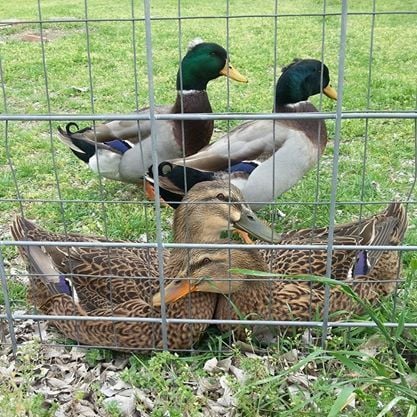- Jun 28, 2011
- 39,160
- 27,377
- 1,302
The Rouen breed was originally raised in France, but it was not until it was imported into England in the 19th century that it was refined into the breed recognized as the Rouen today. The French Rouen resembled a larger than average Mallard, but by selective breeding the British managed to double the size of the bird, improve its coloration and change their body shape, giving it a more "boat-like" aspect. The first Rouens were introduced to the USA in 1850, by D. W. Lincoln of Worcester, Massachusetts, and they were mostly used as general homestead ducks until they started becoming popular as show birds. Due to their large size, they make excellent table birds, but are slow growing and can take up to a year to reach their full size.
The plumage coloring of both the Rouen drake and duck are nearly identical to that of the Mallard breed; drakes have green heads, white collars, black tail feathers, a gray body, and a deep claret breast. The ducks are mottled light and dark brown, with a black crown and eye-stripes. Rouen ducks can be much darker brown than Mallard ducks. Both sexes also have blue speculum feathers. Rouen speculum feathers are brighter in color and larger in size than that of the Mallard though. Adult Rouen birds of both genders are typically significantly larger than Mallards. The Rouen duckling are nearly identical to the Mallard duckling in terms of plumage colouring, but Rouen ducklings can be distinguished from wild Mallard ducklings by the presence of a second stripe which runs across their face, just under their eye, whereas mallard ducklings have only one stripe which runs across their eye. In the USA, two distinct types of Rouen are bred, the common, or "production", variety that is larger than a Mallard but has a typical duck conformation, and the much larger and squarer standard-bred exhibition variety. The production variety normally weighs 6–8 lbs (2.7–3.6 kg) while the standard-bred weighs 9–12 lb (4.1–5.4 kg).
They were included in the APA's Standard of Perfection in 1874.
Details:
Purpose: Dual purpose; exhibition
Egg laying: 60-150 per year
Origin: France
Classification: Heavy
Weight: Production variety - 6–8 lbs; Exhibition variety - 9–12 lb

Pic by @Canam

Pic by @housewife

Pic by @KelliG
BYC Breed discussions:
https://www.backyardchickens.com/t/777392/rouen-duck-thread/0_30
https://www.backyardchickens.com/t/225395/difference-between-rouen-and-mallard/0_30
BYC Breed Reviews:
https://www.backyardchickens.com/products/rouen
Do you own Rouens? Are you a Rouen breeder? If so, please reply to this thread with the your thoughts and experiences, including:
· What made you decide to get this breed?
· Do you own them for fun? Breeding? Some other purpose?
· What are your favorite characteristics about this breed?
· Post some pics of your birds; male/female, chicks, eggs, etc!
The plumage coloring of both the Rouen drake and duck are nearly identical to that of the Mallard breed; drakes have green heads, white collars, black tail feathers, a gray body, and a deep claret breast. The ducks are mottled light and dark brown, with a black crown and eye-stripes. Rouen ducks can be much darker brown than Mallard ducks. Both sexes also have blue speculum feathers. Rouen speculum feathers are brighter in color and larger in size than that of the Mallard though. Adult Rouen birds of both genders are typically significantly larger than Mallards. The Rouen duckling are nearly identical to the Mallard duckling in terms of plumage colouring, but Rouen ducklings can be distinguished from wild Mallard ducklings by the presence of a second stripe which runs across their face, just under their eye, whereas mallard ducklings have only one stripe which runs across their eye. In the USA, two distinct types of Rouen are bred, the common, or "production", variety that is larger than a Mallard but has a typical duck conformation, and the much larger and squarer standard-bred exhibition variety. The production variety normally weighs 6–8 lbs (2.7–3.6 kg) while the standard-bred weighs 9–12 lb (4.1–5.4 kg).
They were included in the APA's Standard of Perfection in 1874.
Details:
Purpose: Dual purpose; exhibition
Egg laying: 60-150 per year
Origin: France
Classification: Heavy
Weight: Production variety - 6–8 lbs; Exhibition variety - 9–12 lb
Pic by @Canam
Pic by @housewife
Pic by @KelliG
BYC Breed discussions:
https://www.backyardchickens.com/t/777392/rouen-duck-thread/0_30
https://www.backyardchickens.com/t/225395/difference-between-rouen-and-mallard/0_30
BYC Breed Reviews:
https://www.backyardchickens.com/products/rouen
Do you own Rouens? Are you a Rouen breeder? If so, please reply to this thread with the your thoughts and experiences, including:
· What made you decide to get this breed?
· Do you own them for fun? Breeding? Some other purpose?
· What are your favorite characteristics about this breed?
· Post some pics of your birds; male/female, chicks, eggs, etc!









